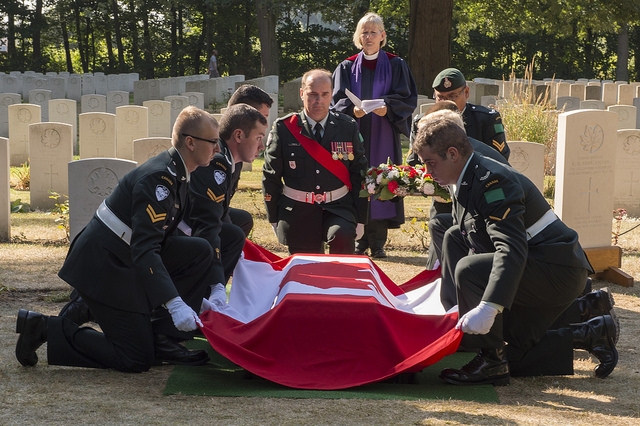History student helps lay WWII veteran, military brother, to rest

On September 14, 1944, Kenneth Donald Duncanson was killed during intense fighting in Belgium during WWII. The Algonquin Regiment, to which he belonged was forced to retreat and in the chaos, Duncanson’s body was left in the Belgian field where he fell. Duncanson’s body remained lost until November 2014, when a hobbyist discovered his remains using a metal detector.
On September 14, 2016, exactly 72 years later, Nicholas McGuire, a Masters of History student at Nipissing University and a serving member of the Algonquin Regiment, helped lay Duncanson to rest with full military honours at Adegam War Cemetery in Belgium in front of dignitaries as well as Duncanson’s family. McGuire served as one of casket bearers in the ceremony.
“I jumped at the chance to be part of the burial task when my platoon commander asked me about it,” said McGuire. “As a history student, it was incredible to see and to take part in this piece of history. It was an amazing and humbling, once-in-a-lifetime experience. Though we did not know him personally, never paraded or trained with him, he was still one of our brothers who wore the Bull Moose cap badge of the Regiment. He fought and died with the Regiment. We lost him, we found him, and we laid a brother to his final rest.”
Private Kenneth Donald Duncanson was from Dutton, Ontario. He joined the Army in 1942 at 29 years old, and was placed in the Algonquin Regiment when he arrived in Europe. He fought with the Regiment in Normandy, through France and into Belgium. Duncanson was killed during an attempt by the Algonquin Regiment to establish a bridgehead crossing of the Dérivation de la Lys (canal) and the Leopold Canal in northern Belgium. It did not go well for the Regiment that day, and the unit was forced to retreat across the canals. Duncanson was killed during that fight. He was one of eight that were reported as missing in action after the battle of Moerkerke.
While in Belgium for the internment ceremony, McGuire, his colleagues and Duncanson's family were given a battlefield tour of Moerkerke and Molentje, where Duncanson died, and saw the place where his body was found. He also had the opportunity to see the Tyne Cot cemetery and took part in the Last Post ceremony at Menin Gate in Ypres, commemorating those British and Commonwealth who died at Ypres with no known grave. He had the chance to meet a World War Two British veteran, the last British airborne soldier who took part in Operation Market Garden.
“Seeing the canals the Regiment went over and fields they fought and died in put the battle and their struggle into a close perspective. Our commanding officer, perfectly summed up our experience in Belgium with the phrase: We witnessed history, we made history and we met history,” said McGuire, who has now returned to his graduate studies at Nipissing, working on a paper that focuses on the Algonquin Regiment. “We do have large gaps in our Regimental history, especially during the Cold War, and I intend to fill in these gaps during my time here at Nipissing University in the masters of History program.”
